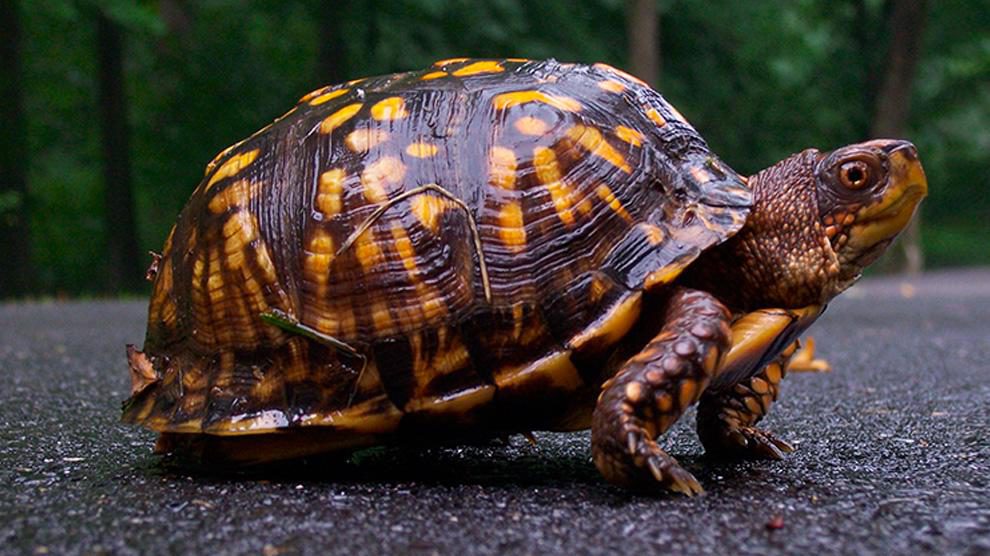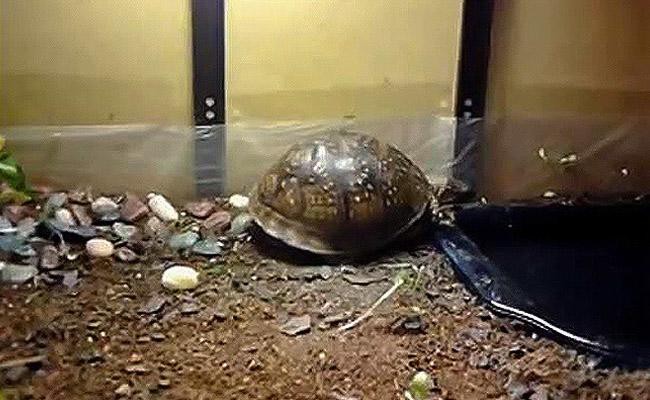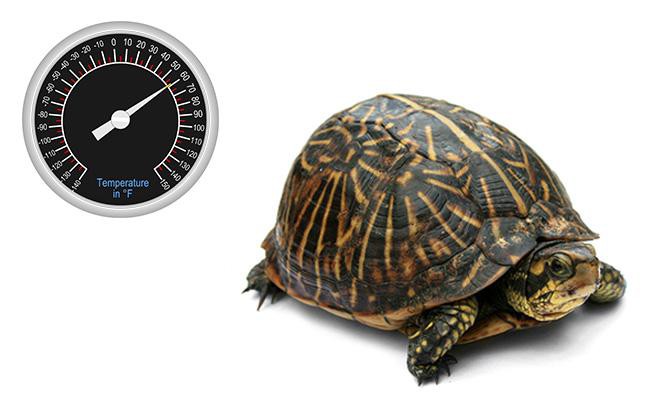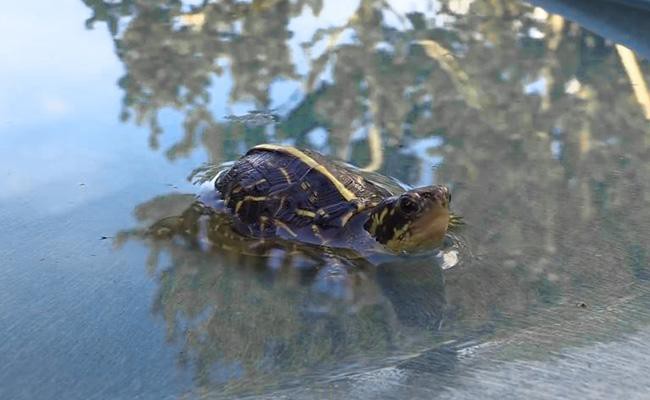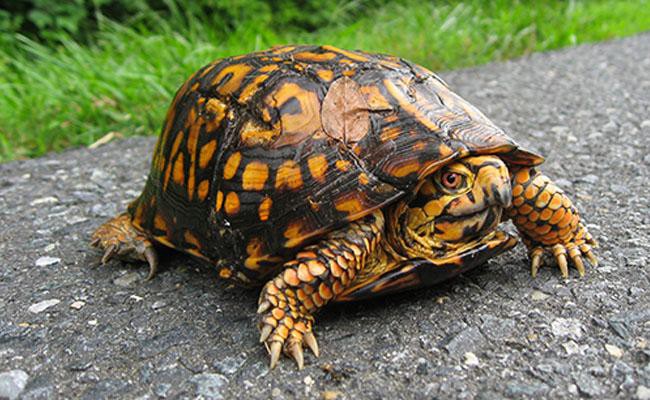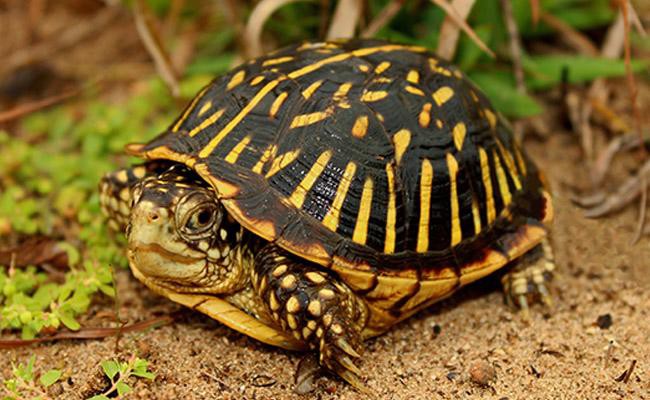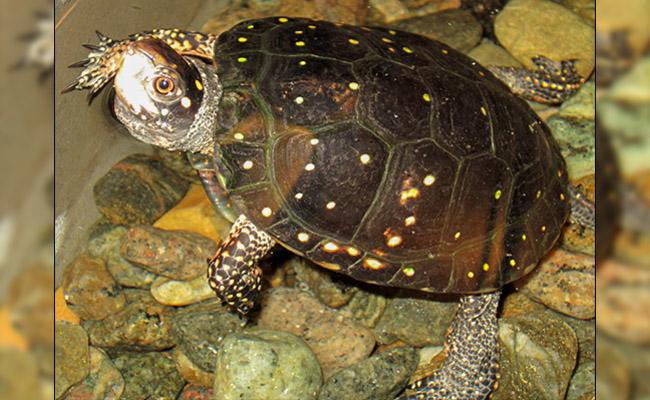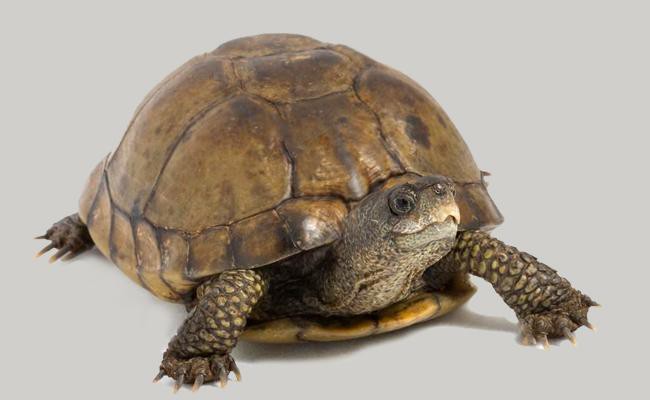- Box turtle Habitat
- Box Turtle Humidity
- Lighting For Box Turtle Outdoor Habitat
- What Do Box Turtles Eat?
- Water For Turtle Pets
- Separate Male From Female Box Turtles
- Box Turtle Health Check-Up
- Eastern Box Turtle (Terrapene Carolina Carolina)
- Ornate Box Turtle (Terrapene Ornata Ornata)
- Three-Toed Box Turtles (Terrapene Carolina Triunguis)
- Gulf Coast Box Turtle
- Western Box Turtle - Terrapene Ornate
- Spotted Box Turtle
- Coahuilan Box Turtle (Terrapene Coahuila)
- Can Box Turtles Swim?
- Box Turtle Male or Female?
- Box Turtle Sounds
How to care for box turtles? Box turtles are recognized as the most popular exotic pet in America. Usually, with excellent care and support, these reptiles live long, with life-spans ranging between 30 to 40 years.
However, box turtles are among the least cared exotic pets in captivity because people seldom learn proper box turtle care.
Therefore, it’s essential that you learn proper box turtle care and follow the same.
Box turtle Habitat
The minimum aquarium size for these aquatic reptiles is twenty-gallon aquariums. Now, you can choose larger aquariums, make big cases using plywood, or try using concrete mixing containers that are available at almost all hardware shops.
According to experts, the bigger the aquarium, the better it looks. Especially, you can use a humid substrate material such as wood chips blended with peat moss as the base material in the enclosure.
In fact, drier substrates enhance poor quality health and cracking. Also, for better performance, scoop substrates regularly and also provide a provision for a hide box.
In addition, loose leaf litter is a better choice to use in the cage.
Box Turtle Humidity
The ideal temperature should not exceed 15 degrees Celsius and 27 degrees Celsius at night and day respectively.
In addition, a 75 or 100-watt bulb with a reflector can support a warm basking area at least at one corner of the enclosure. The ideal temperature of the incandescent bulb is between 28 & 32 degrees Celsius.
During the night, it’s important to switch off the lights, so supplemental heating pads can be provided under one-half of the enclosure if temperature plummets below 60 degrees Fahrenheit.
Note-Hot rocks are not an ideal choice for box turtles. So, avoid them whenever and wherever possible.
Lighting For Box Turtle Outdoor Habitat
Effective lighting is very important psychologically and physiologically. In general, reptiles require daily access to UV-B rays. Also, an additional incandescent light is needed for its light and warmth.
Overall, set the incandescent light so that one section of the enclosure remains warm at 85F.
What Do Box Turtles Eat?
In captivity, chronic nutritional issues are the most common problem faced by the majority of box turtles. Besides, nutritional deficiencies are better avoided by feeding your box turtle with a well-balanced food.
Box Turtle Diet
A sample recommended diet include 50 per cent high-protein and animal foods.
- Some of the foods include baby mice, chopped-mice, snails, slugs, cicadas, grasshoppers, crickets, and earthworms.
- Other protein options also include chows( fortified with vitamins), but they can be limited to not more than five per cent.
- Soak dry chows in water at least for half-an-hour before feeding them.
- Do not feed cat foods since they are filled with the high content of protein and fat.
- Stop using multivitamins to foods already containing the fortified vitamin.
- Feed your box-turtle with wide varieties of high-protein and animal food.
- Since insects suffer from calcium deficiency, you should feed your box-turtle with powdered gluconate, citrate, lactate, or calcium carbonate.
75 per cent vegetables
Varied vegetable includes mushrooms, carrots, sweet potatoes, squashes, broccoli rabe, pak choi, bok choy, dandelions, romaine lettuce, spinach, cabbage, kale, and dark leafy greens.
25 per cent fruits
Although fruit diets are nice and tasty, they are mineral deficient.
In general, turtles love grapefruit, mangoes, bananas, melons, figs, nectarines, oranges, plumbs, pears, peaches, cherries, grapes, apples, raspberries, strawberries, and tomatoes.
How to feed box turtle?
Wash vegetables and fruits and shave and chop them into small pieces. Some species including Gulf Coast or ornate box turtles are not in favour of vegetables. Therefore, mixing veggies with other foods can increase your box-turtle’s consumption.
Since box turtles are always in need of food items rich in A vitamins, try dark leafy greens, dark orange vegetables and mice liver.
Steaming hard squashes can make them easier to chop and more palatable.
Feeding schedule
Juveniles need food daily while adult turtles can manage when they are fed thrice or more every week. With every feeding, kindly add gluconate or citrate or lactate or calcium carbonate.
In case, vitamin-fortified foods are not part of the main diet, you can add multi-vitamins in their diet. For finicky box turtles, try various foods that are in orange, yellow, and red foods. In addition, moving or live foods often increase the appetite.
They are very active and agile in the late afternoon or early morning. So, you can feed them at these times. In general, rainstorms are known to increase activity; therefore spraying water over their enclosure can increase appetite.
Furthermore, when you actually discover something they strongly like, mix that into the salad. But, you should decrease it over a period of time. In particular, bad dietary habits are quite difficult to stop and require plenty of time to correct.
Overall, as the turtle adopts a different diet, it will increase dietary diversity over time.
Water For Turtle Pets
A big clean shallow water bowl, large enough for your box turtle to immerse itself, is a must. As a thumb rule, water should never exceed the turtle’s chin when it is partially inside water.
On the other hand, turtles follow the practice of defecating in the water bowl, and hence it should always be cleaned several times. For your kind information, juvenile box turtle prefers water much more than adults.
To sum up, box turtles love to drown in swimming pools or in deep water.
Separate Male From Female Box Turtles
Suppose, if you are planning to house more than one box turtle, you are advised to house the males in a separate enclosure. Normally, box turtles are known to fight for their territory, female mates, or food.
Box Turtle Health Check-Up
In fact, many individuals only think of cats and dogs when they mean vets. Importantly, box turtles are not like a cat or a dog that shows their grief or emotions more outwardly.
Hence, kindly take them to a vet once every six months without fail.
Well-known medical problems that can affect box turtles
- Trauma
- Retention of eggs
- Skin disorders
- Parasites
- Ear abscesses
- Swollen eyes
- Pneumonia
The Bottomline
In fact, turtles are mostly advertised as very low maintenance pets. However, turtles require plenty of space, love, and care as well. However, if you are ready for a long-term commitment, we request you bring one home from a local rescue group or animal shelter.
Eastern Box Turtle (Terrapene Carolina Carolina)
Not more than 4 or 6 inches, Eastern box turtles have a strong carapace that contains red, orange, yellow or dark brown markings. The skin appears with red or yellow colouration, particularly in males. The Eastern Boxes contain four toes.
Appearance
Male Eastern box turtle has thicker, longer tails compared to the females. The plastron appears slightly flattered in females and more concave in males and the carapace looks domed in females.
The males feature more colourful schemes on the forelegs, and their claws are more curved and shorter compared to their female counterparts. Sometimes male Eastern box turtle has red coloured irises and only experts can gauge the difference between the males and females with ease.
Life expectancy
They are known to live up to 100 years. In captivity, the average life expectancy of an Eastern box turtle is around 40 years.
Light and temperature
When cared for in an outdoor enclosure, the Eastern box turtles require both shady and sunny areas. Indoors, the need for a UVB light source is strong. Create a basking zone with temperature ranging between 85 & 88 F.
Ensure that the temperature at night is maintained around 70 F.
Enclosure
You can maintain these turtles (mainly juveniles and hatchlings) in a big indoor enclosure. They also do very well in large outdoor enclosures. Easy access to water and a safe, secure spot to hide including loose litter.
Water
These turtles are not at all aquatic by nature. They love to soak and drink the same water. Always make sure that water is easily available 24/7. In summer, use a sprinkler to keep the Eastern box turtles enclosure as cool as possible.
Food
They are omnivores and adults prefer grasses, fruit, and vegetables. The Easterns are known to feed on live foods such as grasshoppers, crickets, mealworms, snails, slugs, and earthworms.
Hatchlings are considered a bit more carnivorous and at times cooked dog food and lean meats are also provided.
Interesting facts
- The Easterns are capable enough to survive in a different environment ranging from wet forests to arid grass surfaces.
- They usually hibernate when the habitat turns cold.
- Box turtles are found in Northern Florida, Maine, and also in the eastern
- These turtles are mentioned as threatened and listed by CITES.
- Always buy Eastern box turtles from a well-known breeder and not from pet stores.
Ornate Box Turtle (Terrapene Ornata Ornata)
Appearance
Being native to America (central), ornate box turtles are terrestrial by nature. These turtles possess a domed shell that appears brown with pale yellow lines. The scutes, for instance, feature radiating brown and yellow lines.
Their skin appears dark grey and male ornate have a green colour on their head. The ornate box turtle does not cross more than 6 inches.
Temperament
These turtles mostly live in natural grasslands and deserts. The males feature reddish iris and unlike the Easterns, the plastron is flat for both females and males. The females have smaller tails than males.
Stressed out ornate box turtles can cause bite injuries; so handle them with. They hibernate in winter and captive turtles do what experts call as burrowing.
Enclosure
The ornate box turtles perform best in an outdoor environment. They normally dislike indoors. Large enclosure with plenty of moving space with a high fence. Make provision for hiding including planks and logs.
If placed indoors, a suitable enclosure should be constructed with ample lighting and heating. In outdoors, create a separate place for basking by providing both sunny and shady areas.
Humidity
These turtles create a solid environment by burrowing. It’s important to burrow into loose soil at least 3 to 4 inches thick. Regular sprinkling or misting is advised along with a bowl of water.
Temperature
They prefer temperature in the vicinity of 85 – 88 F and 70 – 75 F during day and night respectively. Ornate box turtles hibernate in the cold season. Make provision for a heat source in warm summer months.
Food
The regular diet of ornate box turtles includes pinky mice, earthworms, waxworms, mealworms, and crickets. Fruits, vegetables, leafy greens, and grasses are also preferred by ornate box turtles.
Most ornate box turtles are messy eaters.
Health Issues
They mostly suffer from
- Parasites
- Respiratory infections
- Vitamin A deficiency
Box turtles are also susceptible to shell rot. The odour emanating from the shell will confirm the presence of shell rot. Always avoid home remedies and contact your vet for further treatment.
Interesting facts
- Not suitable for newbies, ornate box turtles are quite sensitive to stress.
- Always choose domestic turtles from a reputable breeder for best results.
- Young ornate box turtles are carnivorous while adults are more omnivorous.
- Mostly found in Illinois and South Dakota in the US, ornate box turtles have a very long lifespan not less than 100 years.
Three-Toed Box Turtles (Terrapene Carolina Triunguis)
These classic, interesting turtles are native to America and three-toed box turtles are mostly suited for experienced turtle owners. This one prefers more care and attention and they can get stressed just like that.
Appearance
Three-toed box turtles have a shell that’s mostly light military brown with yellow markings. On the chest, they have dark sections. The skin appears brown with yellow markings. Male three-toed box turtles have black, orange, red on the forelegs and neck.
They also have red spots on their heads. Female three-toed box turtle has shorter, thinner tails than the males. The plastron looks a bit flatter in females and more concave in males.
They contain red-irises, particularly the males. Male three-toed box turtle has claws that are more curved and shorter, especially on their hind legs.
Lifespan
The three-toed box turtles live normally around 40 years as domestic pets and grey 100 years without captivity.
Size
Not more than 5.5 inches in size, three-toed box turtles are not a gigantic breed.
Temperament
These turtles can live in various habitats, ranging from thick woodlands to meadows. Found in Alabama, Texas, and Missouri, the three-toed hibernate in colder climates. They love to stay active longer in warmer climates.
Being very sensitive by nature, the three-toed box turtles cannot be considered as an easy pet for all. This turtle spends more time in water compared to other box turtle breeds.
Heat
If grown in an outdoor enclosure, ensure that the enclosure contains both shady and sunny areas, as the turtle loves to move from warmer to cooler areas.
Indoor enclosures need UVB –emitting light source. The nighttime temperature cannot reach below 70 F and the baking temperature must be maintained between 85 and 88 F.
Food
Being omnivores, the three-toed boxes eat grasses, fruit, and vegetables. Other food items include small fish, grasshoppers, crickets, mealworms, snails, slugs, and earthworms.
Hatchlings eat more carnivorous food and dog food without fat is also a better option.
Housing
Under favourable conditions, the three-toed box turtles prefer more access to lose litter and easy hiding spots. Large enclosure with access to clean water, the three-toed boxes would love to get in the water without drowning or tipping.
These turtles are fond of humid conditions.
Health Issues
The three-toed box turtles mainly suffer from-
- Internal parasites
- Shell rot
- Vitamin A deficiency
- Respiratory defects
The symptoms of respiratory issues include drooling, nasal leak, wheezing, and frequent open-mouthed breathing. Parasitic infections are also hard to detect without the help of a vet.
Choosing Three-Toed Box Turtles
Any redness or bumps on the carapace, cloudy eyes or mucus in the mouth may show a three-toed box turtle with serious health issues.
Gulf Coast Box Turtle
These turtles are known to survive in different habitats. The Gulf Coast box turtles feed on amphibian larvae and insects. Mostly seen between western Florida and eastern Texas, Gulf Coast box turtles are larger in size than others.
Appearance
They have a domed shell that appears black or brown with very little markings. Juveniles consist of yellow markings. Females normally have red irises and shorter, thinner tails than their male counterparts.
Males have plastron concave in shape while females have a flatter one. Gulf-Coast box turtles are very shy and in the wild, they require a lot of places, and regular access to unfiltered sunlight.
Life Expectancy
The average life expectancy of a Gulf-Coast box turtle is not more than 40 years in captivity and 100 years in the wild.
Size
Their average size is between 5 to 7 inches long.
Food
Adults require a varied diet and are omnivores. They like grasshoppers, crickets, mealworms, snails, slugs, and earthworms. Juveniles are more carnivorous.
Gulf Coast box turtles need to get the correct phosphorous and calcium balance in the diet. Some of the best fruits and vegetable options include papaya, apples, grapes, blueberries and collard greens, spinach, dandelion greens, and parsley.
Natural and fresh prey insects from bait shops are an ideal choice. Never feed Gulf-Coast turtle insects with insects caught outside. Other protein-rich diets include cooked meat and low-fat moistened dog food.
Overall, add a multivitamin supplement and reptile calcium at least two times a week in Gulf-Coast Box turtle diet.
Health Issues
The health issues faced by a Gulf Coast turtle include
- Weakened bones
- Respiratory infections
- Vitamin A deficiency
- Parasitic infections
- Shell rot
Kindly avoid treating these animals at home. Take him to a vet and arrange for immediate medical treatment.
How to choose this Gulf-Coast box turtle?
Gulf Coast box turtles are most suitable for experienced pet owners and not for beginners. Always buy a Gulf Coast box turtle from a responsible and popular breeder to avoid any unnecessary health issue.
Western Box Turtle - Terrapene Ornate
The Western box turtles are the best known amazing reptiles with a clumsy gate, soulful face, and reclusive habits.
Appearance
These turtles have yellow markings to a brownish, drab olive, based on the turtle’s subspecies.
There are two popular subspecies of Western box turtle
- Desert box turtle (Terrapene ornata luteola)
- Ornate box turtle ( Terrapene ornata ornata)
In most cases, the desert box turtles are quite bigger, and this is completely based on the turtle’s age. Without a raised keel and the carapace almost flattened, Western box turtles are found with a yellow line.
Female Western box turtles have brown eyes while males have red eyes. Unlike females, males have a flattened toe completely on their back legs.
Habitat
Based on their subspecies, western box turtles survive on prairies and also in deserts. The desert box turtles are more suitable to live on arid or dry conditions. The ornate box turtle lives on grasslands and treeless sandy plains.
Life Span
A western box turtle is known to live for at least 40 years.
Size
Both female western box turtle and male western box turtle, the shell can easily stretch over 15 cms. The carapace is normally in brown or black colour with bright yellow stripes.
The ornate box turtles have lesser stripes compared to a desert box turtle. Western box turtles have a carapace that’s actually less domed and also a bit more flattened than the rest.
Food
They thrive on berries, carrion, worms, spiders, and insects. Some western box turtles are known to feed on caterpillars, grasshoppers, and beetles.
Choosing your Western Box Turtle
Please bear in mind that keeping, buying, or catching a forest caught western may not a good idea since wild grown turtles have very less chance to survive in captive conditions.
Adopt a western box turtle from a reputable breeder only with proper documents.
Spotted Box Turtle
The Spotted Box Turtle belongs to the Genus Terrapene.
There are two popular sub-species
- Southern Spotted Box Turtle (Terrapene Nelsoni Nelsoni)
- Northern Spotted Box Turtle (Terrapene Nelsoni Klauberi)
Appearance
These animals have distinct spotted patterns. They also have numerous dots on their shell. With a hinged shell, the spotted box turtle that helps it to withdraw its entire body completely inside.
Lifespan
In captivity, the spotted box turtles are found to live a minimum of 25 years.
Habitat
They are an endemic species. Spotted box turtles survive in isolated location only. The Sierra Madre Occidental in Mexico is only placed where these animals are found.
Food
Omnivores like spotted box turtle are known to consume beetles, crickets, cockroaches, snails, and slugs. They also feed on moss, lettuce, and certain varieties of grass.
Their diet also includes mushrooms and berries.
Housing
Humidity plays a main role in the care of a spotted box turtle. Other than this, plenty of clean water must be provided. Spotted box turtles prefer privacy and for this matter, you should provide logs and brush for them to hide.
Make provision for a lamp so that the spotted box turtles can manage their body temperature.
Choosing your Spotted Box Turtles
The cost of buying one in America is not only difficult but expensive too. The lack of information about this species could invariably make it difficult to care for.
Coahuilan Box Turtle (Terrapene Coahuila)
Belonging to the Emydidae family, Aquatic box turtle or Coahuilan box turtle spend their entire time in the water. The most interesting factor about this turtle is that it spends its entire life almost in the water.
Appearance
The Coahuilan box turtle has a hinged shell. The skin looks dark grey or dark brown, but certain areas can look totally black.
Habitat
It is found in Coahuila, Mexico. During the rains, Coahuilan box turtles leave for the desert.
Size
Not more than 15 to 18 cms long, the Coahuilans are known for their darker splotches.
Lifespan
The exact life expectancy of this turtle is unknown.
Housing
Building an enclosure for the Coahuilan’s is best left to experts in turtle care and wildlife professionals. The most vital aspect of their housing is the aquatic zone. This zone should be big enough to give them a lot of space to move about.
Eleocharis, a plant that is grown in their habitat, must be included in the design of the enclosure. UV lighting is very much necessary for this turtle to regulate their body temperature.
Food
The Coahuilan box turtles are opportunistic feeders. They devour both animals and plant-based food equally. It will, for example, feed on plant matter, crayfish, fish, reptiles, true bugs, beetles, dragonfly nymphs, and fly larvae.
Can Box Turtles Swim?
Yes, they can for sure. All box turtles require water, both for soaking and drinking purpose. It’s important that the water remains shallow and clean. They can swim but only for some time. Box turtles can also get tired and drown if they are in deep waters and may find it difficult to escape.
Turtles are not like other aquatic animals and they can find it difficult to breathe underwater. Adult turtles are brilliant enough to come to the surface to breathe. The secret is to understand your turtle’s uniqueness and their needs and provide them with the right habitat.
Box Turtle Male or Female?
Sexual differentiation in these animals happens when they reach 4 or 5 years old. Females have grey or brown eyes and males have red colour eyes.
The plastron appears flat in a female box turtle and concaves in males. The males also have longer and larger tails compared to the females.
Box Turtle Sounds
Like other turtles, box turtles can also vocalize. They may use it to find potential mates. According to experts, juvenile box turtles vocalize to gain attention. Sick or stressed turtles may also produce sounds.
Turtles are popular for their hissing sound; in fact, it’s actually their breathing that produces the sound.

